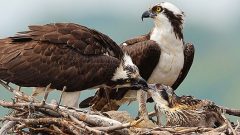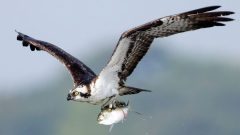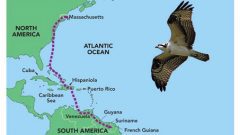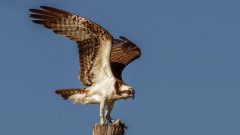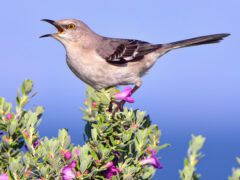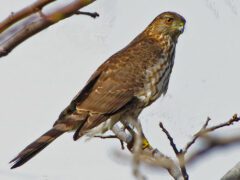Osprey Similar Species Comparison
Main SpeciesOsprey
Adult (Australasian)
"Australasian" Osprey has a distinctive combination of pale head and dark breast band that separates it from other subspecies.
© Hans Wohlmuth / Macaulay LibraryNew South Wales, March 26, 2017Adult (carolinensis)
Constructs prominent large stick nests on platforms or large trees.
© Beth and Dan Fedorko / Macaulay LibraryVirginia, March 25, 2017Adult (carolinensis)
Large. Brown back and wings contrast with the white underparts. Head white with a broad brown line through the eye, beak black and strongly hooked.
© Kris Perlberg / Macaulay LibraryFlorida, January 26, 2017Adult (haliaetus)
Breeds widely in the Northern Hemisphere, with the "haliaetus" group found in Eurasia and the "carolinensis" group nesting across much of the United States and Canada.
© Christoph Moning / Macaulay LibraryMuscat, December 09, 2008Adult (carolinensis)
Call is a high-pitched series of short whistles. The calls are often slow and paced far apart—when the speed increases, it's often a response to a threat or an unfamiliar Osprey approaching.
© Benjamin Clock / Macaulay LibraryMaine, June 21, 2013Adult (Australasian)
"Australasian" Osprey is smaller than birds that breed across Eurasia.
© David Irving / Macaulay LibraryNew South Wales, July 26, 2020Adult (haliaetus)
Has large feet with a unique structure for holding onto slippery fish prey.
© Marc FASOL / Macaulay LibraryVästmanlands län [SE-19], July 25, 2018Adult
Flies on slightly bowed wings with a kink at the wrists, creating an M-shape when seen from below.
© Eric Liner / Macaulay LibraryFlorida, January 20, 2009Adult (carolinensis)
Feeds exclusively on fish.
© David Brown / Macaulay LibraryPennsylvania, April 11, 2017Adult (ridgwayi)
Osprey breeding in the Caribbean (part of the "ridgwayi" group) are pale, appearing almost white-headed.
© Hal and Kirsten Snyder / Macaulay LibraryFlorida, May 03, 2018Adult (carolinensis)
Large raptor that eats fish exclusively. Note mostly white head with brown line behind eye.
© Larry Arbanas / Macaulay LibraryCalifornia, May 01, 2005Adult (carolinensis)
In flight shows white belly and underwings contrasting with brown "wrists" and strongly barred flight feathers.
© Jay McGowan / Macaulay LibraryNew York, May 23, 2015Juvenile (carolinensis)
Juvenile has brown upperparts with extensive white edging, a buffy wash on the nape and breast, and orange eyes.
© Matt Felperin / Macaulay LibraryMaryland, July 09, 2020Adult (carolinensis) with nestlings
Builds big stick nests in trees and on open-topped platforms. Juveniles have white edging to the back and wing feathers, creating a scaly appearance.
© Jay McGowan / Macaulay LibraryNew York, August 05, 2012Juvenile (carolinensis)
Juvenile has brown upperparts with extensive white edging.
© William Keim / Macaulay LibraryNew Jersey, July 25, 2017Adult (carolinensis)
Can show a distinct crest, depending on wind direction and mood.
© Ferit Başbuğ / Macaulay LibraryFlorida, January 27, 2015Adult (Australasian)
"Australasian" Osprey has a distinctive combination of pale head and dark breast band that separates it from other subspecies.
© Hans Wohlmuth / Macaulay LibraryNew South Wales, March 26, 2017Adult (carolinensis)
Constructs prominent large stick nests on platforms or large trees.
© Beth and Dan Fedorko / Macaulay LibraryVirginia, March 25, 2017Adult (carolinensis)
Large. Brown back and wings contrast with the white underparts. Head white with a broad brown line through the eye, beak black and strongly hooked.
© Kris Perlberg / Macaulay LibraryFlorida, January 26, 2017Adult (haliaetus)
Breeds widely in the Northern Hemisphere, with the "haliaetus" group found in Eurasia and the "carolinensis" group nesting across much of the United States and Canada.
© Christoph Moning / Macaulay LibraryMuscat, December 09, 2008Adult (carolinensis)
Call is a high-pitched series of short whistles. The calls are often slow and paced far apart—when the speed increases, it's often a response to a threat or an unfamiliar Osprey approaching.
© Benjamin Clock / Macaulay LibraryMaine, June 21, 2013Adult (Australasian)
"Australasian" Osprey is smaller than birds that breed across Eurasia.
© David Irving / Macaulay LibraryNew South Wales, July 26, 2020Adult (haliaetus)
Has large feet with a unique structure for holding onto slippery fish prey.
© Marc FASOL / Macaulay LibraryVästmanlands län [SE-19], July 25, 2018Adult
Flies on slightly bowed wings with a kink at the wrists, creating an M-shape when seen from below.
© Eric Liner / Macaulay LibraryFlorida, January 20, 2009Adult (carolinensis)
Feeds exclusively on fish.
© David Brown / Macaulay LibraryPennsylvania, April 11, 2017Adult (ridgwayi)
Osprey breeding in the Caribbean (part of the "ridgwayi" group) are pale, appearing almost white-headed.
© Hal and Kirsten Snyder / Macaulay LibraryFlorida, May 03, 2018Adult (carolinensis)
Large raptor that eats fish exclusively. Note mostly white head with brown line behind eye.
© Larry Arbanas / Macaulay LibraryCalifornia, May 01, 2005Adult (carolinensis)
In flight shows white belly and underwings contrasting with brown "wrists" and strongly barred flight feathers.
© Jay McGowan / Macaulay LibraryNew York, May 23, 2015Juvenile (carolinensis)
Juvenile has brown upperparts with extensive white edging, a buffy wash on the nape and breast, and orange eyes.
© Matt Felperin / Macaulay LibraryMaryland, July 09, 2020Adult (carolinensis) with nestlings
Builds big stick nests in trees and on open-topped platforms. Juveniles have white edging to the back and wing feathers, creating a scaly appearance.
© Jay McGowan / Macaulay LibraryNew York, August 05, 2012Juvenile (carolinensis)
Juvenile has brown upperparts with extensive white edging.
© William Keim / Macaulay LibraryNew Jersey, July 25, 2017Adult (carolinensis)
Can show a distinct crest, depending on wind direction and mood.
© Ferit Başbuğ / Macaulay LibraryFlorida, January 27, 2015Adult (Australasian)
"Australasian" Osprey has a distinctive combination of pale head and dark breast band that separates it from other subspecies.
© Hans Wohlmuth / Macaulay LibraryNew South Wales, March 26, 2017Adult (carolinensis)
Constructs prominent large stick nests on platforms or large trees.
© Beth and Dan Fedorko / Macaulay LibraryVirginia, March 25, 2017Similar SpeciesRed-tailed Hawk
Adult (borealis)
Red-tailed Hawks have much stouter and broader wings (without the Osprey’s kink at the wrists) and a shorter, broader tail. Though Red-tailed Hawks usually have pale underparts, they’re streaked with brown, particularly across the belly.
© Jonathan Eckerson / Macaulay LibraryMassachusetts, February 18, 2017Similar SpeciesTurkey Vulture
Adult (Northern)
Turkey Vultures have dark bodies unlike the white bodied Osprey.
© Matt Davis / Macaulay LibraryCalifornia, January 01, 2017Similar SpeciesBald Eagle
Adult
Bald Eagles are larger than Osprey. Adults have a clean white tail and dark body, whereas Osprey have a banded tail and a white body.
© Steven Mlodinow / Macaulay LibraryColorado, January 10, 2017Similar SpeciesBald Eagle
Juvenile
Juvenile Bald Eagles are heavily mottled with white and brown, but they don’t have the Osprey’s clean white body.
© Always An Adventure Inc. Team / Macaulay LibraryQuebec, February 12, 2017Similar SpeciesRed-tailed Hawk
Adult (borealis)
Red-tailed Hawks have much stouter and broader wings (without the Osprey’s kink at the wrists) and a shorter, broader tail. Though Red-tailed Hawks usually have pale underparts, they’re streaked with brown, particularly across the belly.
© Jonathan Eckerson / Macaulay LibraryMassachusetts, February 18, 2017Similar SpeciesTurkey Vulture
Adult (Northern)
Turkey Vultures have dark bodies unlike the white bodied Osprey.
© Matt Davis / Macaulay LibraryCalifornia, January 01, 2017Similar SpeciesBald Eagle
Adult
Bald Eagles are larger than Osprey. Adults have a clean white tail and dark body, whereas Osprey have a banded tail and a white body.
© Steven Mlodinow / Macaulay LibraryColorado, January 10, 2017Similar SpeciesBald Eagle
Juvenile
Juvenile Bald Eagles are heavily mottled with white and brown, but they don’t have the Osprey’s clean white body.
© Always An Adventure Inc. Team / Macaulay LibraryQuebec, February 12, 2017Similar SpeciesRed-tailed Hawk
Adult (borealis)
Red-tailed Hawks have much stouter and broader wings (without the Osprey’s kink at the wrists) and a shorter, broader tail. Though Red-tailed Hawks usually have pale underparts, they’re streaked with brown, particularly across the belly.
© Jonathan Eckerson / Macaulay LibraryMassachusetts, February 18, 2017Similar SpeciesTurkey Vulture
Adult (Northern)
Turkey Vultures have dark bodies unlike the white bodied Osprey.
© Matt Davis / Macaulay LibraryCalifornia, January 01, 2017Compare with Similar Species
Click on an image to compare


